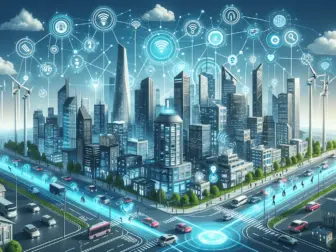Tag - Smart Agriculture
AI and Machine Learning, Blog , February 19, 2025 , AI in Healthcare, AI Robots, AIoT, Artificial Intelligence, Edge Computing, energy management, Industrial AI, iot, Logistics Automation, Smart Agriculture
AI and Machine Learning, Blog , January 26, 2025 , AI-Driven IoT, automation, Big Models, Data Analysis, Edge Computing, Industrial IoT, iot, Smart Agriculture, Smart Decision-Making
Smart Agriculture leverages advanced technologies to increase the efficiency and sustainability of farming practices.
Smart Agriculture leverages advanced technologies to increase the efficiency and sustainability of farming practices.
In recent years, Smart Agriculture has emerged as a revolutionary approach in the field of farming, combining modern technology with traditional agricultural practices to create a more efficient, sustainable, and productive food production system. Smart Agriculture, also known as precision agriculture or smart farming, involves the integration of advanced technologies such as the Internet of Things (IoT), big data analytics, artificial intelligence (AI), robots, and drones to monitor, automate, and optimize various farming processes.
At the core of Smart Agriculture is the use of IoT devices such as sensors, which are deployed across the farm to collect data about soil conditions, plant health, weather patterns, and livestock wellness. This data is transmitted to a central system where it is analyzed to provide farmers with detailed insights into their operations. The information gathered helps farmers make informed decisions about when to plant, irrigate, fertilize, and harvest, leading to more efficient resource utilization and increased crop yields.
AI plays a significant role in Smart Agriculture by aiding in the prediction of weather patterns, the detection of pests and diseases, and the automation of labor-intensive tasks. AI-powered systems can suggest the optimal planting schedules and crop rotations that will yield the best results based on historical data and real-time conditions. Machine learning algorithms can analyze crop images captured by drones to identify areas affected by diseases or pests and recommend targeted treatments, minimizing the use of pesticides and herbicides.
Automation is another key aspect of Smart Agriculture. Autonomous tractors and harvesters, guided by GPS and AI, can operate with minimal human intervention, saving time and reducing labor costs. Drones are used for various purposes, including aerial surveillance of large fields, spraying of fertilizers or pesticides, and even planting seeds. The adoption of robotic systems for tasks such as weeding, pruning, and picking has also gained traction, especially in high-value crops where precision is crucial.
Smart Agriculture is also about sustainability. By precisely applying water and nutrients, farmers can limit the environmental impact of their operations. Smart irrigation systems ensure that water is used judiciously, reducing waste and preventing runoff. Similarly, precision fertilization helps in maintaining soil health and reducing the leaching of chemicals into water bodies.
In addition to environmental benefits, Smart Agriculture offers economic advantages. With better management and reduced input costs, farmers can increase their profit margins. The ability to track and optimize every aspect of farming also leads to a more predictable and stable food supply, which is increasingly important in the face of climate change and a growing global population.
The implementation of Smart Agriculture is not without challenges. It requires significant investment in technology and training for farmers to adapt to new tools and methods. Connectivity issues in rural areas can also hinder the effectiveness of IoT devices and data analysis. Despite these hurdles, the potential benefits make Smart Agriculture an important step towards a more efficient and sustainable future for agriculture.
As technology continues to advance, Smart Agriculture will likely become even more sophisticated, with innovations in areas like gene editing, vertical farming, and renewable energy integration further transforming the way we grow our food. While the transition to Smart Agriculture is a gradual process, it holds the promise of helping farmers around the world meet the demands of the 21st century.


